There are several sauces and pastes that are very important to Thai cuisine, and Thai chili paste or nam prik pao, is one of them. Nam prik pao is a savoury and sweet paste with a uniquely rich flavour. It's versatile and essential in many of Thailand's most popular dishes, such as the famous tom yum goong soup. It can be hard to find, but thankfully it's not at all difficult to make at home, and the homemade version always tastes better!
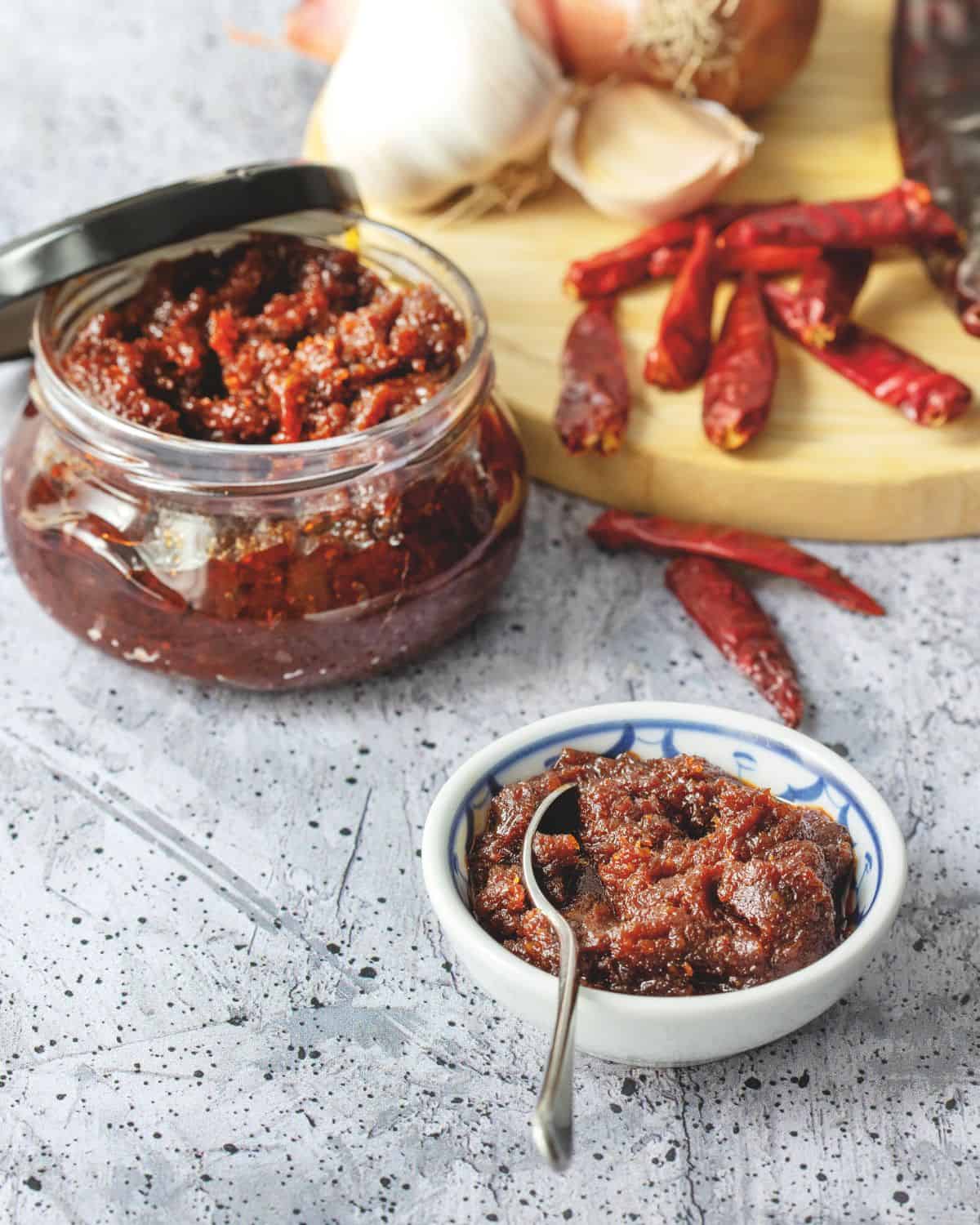
What is Nam Prik Pao?
Nam prik pao น้ำพริกเผา is an extremely versatile ingredient and a staple in any Thai kitchen. It is a paste made primarily from dried chilies, shallots, garlic, and dried shrimp, all of which are ground into a paste, then seasoned and cooked in oil until thick and shiny. Though it is a savoury ingredient, nam prik pao is quite sweet.
The flavour profile of nam prik pao is quite unique, with robustness coming from toasted dried chilies and garlic and shallots that cook down until jammy. When it is added to a dish, it is usually an important part of the dish's identity, and you really can't substitute it with another ingredient.
In Thai cuisine, nam prik pao is used in many different ways, most commonly in soups, stir fries, and salads. More on different ways to use it below.
Ingredients and Notes
Here are all the ingredients you'll need to make this recipe and important notes about them. For amounts, check out the full recipe card below.
- Dried mild chilies. Nam prik pao is not supposed to be very spicy, so stick with large mild chilies such as guajillo or puya peppers. In Thailand, we use dried spur chilies. If you want to make it spicy, however, that's totally fine, in which case feel free to add spicy dried chilies to the paste in addition to the mild.
- Dried shrimp. These add loads of umami to the paste. You can find dried shrimp at any Asian grocery stores in the fridge, and I would choose medium size ones for this recipe.
- Garlic, peel but leave the cloves whole
- Shallots, peeled and cut into large chunks
- Tamarind paste, also labelled as "tamarind concentrate". Make sure it is a product of Thailand which should come as a brown liquid. Indian "tamarind concentrates," which are a sticky, black paste, are much more concentrated and the same amount cannot be used for this recipe. You can also make your own tamarind paste from pulp.
- Salt
- Fish sauce
- Palm sugar, finely chopped, packed. If palm sugar is not available, you can substitute light brown sugar.
- Shrimp paste, optional. Fermented shrimp paste or gapi adds extra umami that's different from the dried shrimp, but it can be omitted.
- Neutral flavoured oil. Quite a lot of oil is added to the paste in order to achieve a luscious, spreadable consistency. In commercial versions of this paste, more oil is used to the point where there is always a thick layer of oil that it on top of the paste, but at home you just need to add enough for the right consistency.
Watch The Full Video Tutorial!
All my recipes come with step-by-step video tutorials with extra tips not mentioned in the blog post, so make sure you watch the video below to ensure success - and if you enjoy the show, please consider subscribing to my YouTube channel. Thank you!
How to Make Thai Chili Paste/Chili Jam - Nam Prik Pao
Here's the bird's eye view of the process, the full instructions are in the recipe card below. If this is your first time, I highly recommend watching the video tutorial to ensure success.

- Toast the dried chilies in a dry skillet over medium heat, stirring constantly, until they are charred in some spots and smell smoky. Remove from the pan and set aside. (See alternate broiler method for toasting chilies below)
- In the same pan, add garlic and shallots and toast over high heat, stirring constantly, until they are charred. Remove from the pan. (See alternate broiler method below)
- In a coffee grinder, grind dried chilies into a powder.
- Add dried shrimp and grind until fine.

- In a food processor or a blender, add all ingredients except the oil.
- Grind into a fine paste, adding more oil as needed for the paste to grind effectively. Scrape the sides down occasionally.
- Transfer the chili paste into a pot or a wok along with any remaining oil. Cook over low heat, stirring constantly to cook the herbs and thicken the paste to a spread consistency. If you are making a large batch, it will take more time to cook.
- Once the paste is dark and thick, with the oil sizzling out of the paste, it is ready to be used or stored.
Alternate Method for Charring Chilies, Garlic and Shallots: Broiler
Traditionally the chilies, garlic and shallots are toasted in a wok or skillet because Thai people don't use ovens. But charring them under the broiler works just as well, and you may find it more convenient as it is more hands-off. This is what I would suggest you do if making a large amount.
For the chilies: Place the dried chilies on a foil-lined baking sheet, and place them under the broiler about 6-8 inches away from the element. Watch them constantly, and pull them out once charred spots form and they smell smokey - this can take less than 1 minute on some broilers.
For the garlic and shallots: On the same baking sheet you used for the chilies, place whole garlic cloves with the skin on on one side of the pan, and the shallots on the other. Broil them on the top rack, as close the element as possible, until some charred spots form on the shallots, about 5 minutes. Flip and broil the other side until more charred spots form, about 3 more minutes. Remove and peel the garlic.
Continue with the recipe as usual.
Save this recipe!
How to use Thai chili paste
Nam prik pao can be used in just about anything - soups, stir fries, salads, or even as a spread! The most famous use for nam prik pao is probably our tom yum goong soup.
In stir fries, simply add it in addition to your other seasonings, but remember that it is quite sweet. See my cashew chicken recipe as an example for how to use it in stir fries. We also love it in fried rice, such as in this 3-chili Thai basil fried rice.
I also love adding Thai chili paste to salads, like in this wing bean salad to make a richer dressing. And for a non-traditional use, you can spread it on toast or crostini as a snack, or use it instead of mayo for your burgers. When I was a kid, my mom used to make tuna sandwiches using nam prik pao as a spread on the bread!
Should you make or buy Thai chili paste?
The truth is that most Thai people buy nam prik pao, and it's a very common ingredient in any supermarket in Thailand. But overseas, it can be hard to find, so if you cannot find it, your only option is to make it yourself because there really isn't a good substitute. Thankfully, making it isn't hard at all!
If you're lucky enough to have it available, or if you're willing to buy online, my recommended brand that is available overseas is Maepranom. Pantai brand is a little sweet for my taste but it is totally fine to use; it seems to be the most commonly available exported brand, and indeed it is the only one that I can get here in Vancouver.
Storage
You can keep Thai chili paste in a sealed jar in the fridge and it'll last several months. You can also freeze it indefinitely.
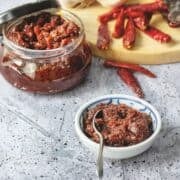
Thai Chili Paste (chili jam) - Nam Prik Pao
- Prep Time: 10 mins
- Cook Time: 40 mins
- Total Time: 50 minutes
- Yield: about 2 cups
Description
Thai chili paste or nam prik pao is a staple in any Thai kitchen. This savoury, sweet paste can be used in various dishes including many of the most popular Thai dishes!
Ingredients
Save this recipe!
- 1.7 oz (50 g) mild dried chilies such as guajillo or puya
- 3.5 oz (100 g) garlic, about 2 heads, cloves separated and peeled (see note 1)
- 7 oz (200 g) shallots, peeled and cut into 1-inch chunks
- ¼ cup (30 g) dried shrimp, medium size
- ¼ cup (60 ml) tamarind paste, store bought or homemade (see note 2)
- 3 Tbsp + 1 tsp (50 ml) fish sauce
- ⅓ cup + 1 Tbsp (80 g) palm sugar, finely chopped, packed
- 1 tsp (5 ml) fermented shrimp paste, optional
- ¾ cup (180 ml) neutral oil (see note 3)
Instructions
- If dried chilies feel dusty, dunk them for just a few seconds in cold water and dry them off on paper towel. Cut them into large chunks with scissors and remove the seeds and pith to reduce spiciness. If you want a spicier chili paste, you can leave some of the seeds in.
- Stovetop Method: Toast the dried chilies in a dry skillet or wok over medium heat, stirring constantly, until they are charred in some spots and smell smoky. Remove from the pan. In the same pan, add the garlic and shallots and stir constantly over high heat until charred spots form. Remove from pan and skip to step 4.
- Broiler Method:
Place the dried chilies on a foil-lined baking sheet, and place them under the broiler about 6-8 inches away from the element. Watch them constantly, and pull them out once charred spots form and they smell smokey - this can take less than 1 minute on some broilers.
On the same baking sheet you used for the chilies, place whole garlic cloves with the skin on on one side of the pan, and the shallots on the other. Broil them on the top rack, as close the element as possible, until some charred spots form on the shallots, about 5 minutes. Flip and broil the other side until more charred spots form, about 3 more minutes. Remove and peel the garlic.
- In a coffee grinder, grind the dried chilies into a powder, then add the dried shrimp and grind until fine.
- In a food processor, add all ingredients except the oil and grind into a fine paste, adding the oil gradually as needed for the food processor to grind more effectively. Scrape the sides down occasionally. Grind until you have paste that's mostly fine but it does not need to be smooth.
- Transfer the chili paste into a wok or skillet along with any remaining oil. Cook over low heat, stirring constantly, for about 20 minutes to cook the herbs and to thicken the paste to a consistency of a spread. If you are making a large batch, it will take more time to cook.
- Store in a glass jar, and it'll keep in the fridge for a few months or in the freezer indefinitely. Use as a spread on crackers, toast, burgers and sandwiches, or use in any of these recipes: Cashew Chicken, Tom Yum Goong, Shrimp & Chili Paste Stir-Fry, Roast Pork Salad, Thai Tuna Salad, Wing Bean Salad
Notes
- If using broiler method to toast garlic, there is no need to peel them as the peel will come off easily after broiling.
- When buying tamarind paste, it can sometimes be labelled as "tamarind concentrate," but make sure it is a product of Thailand which should come as a brown liquid. Indian "tamarind concentrates" are much more concentrated and the same amount cannot be used for this recipe.
- In commercial versions of this paste, more oil is typically used to the point where there is always a thick layer of oil that it on top of the paste. I don't like to add that much, but if you want to replicate the "traditional" style feel free to add more oil.

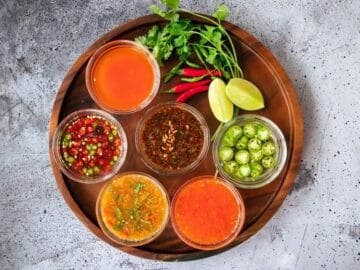
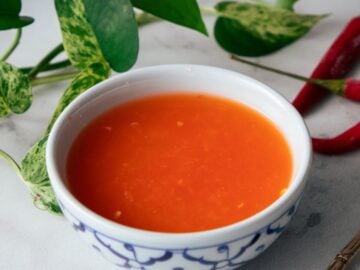
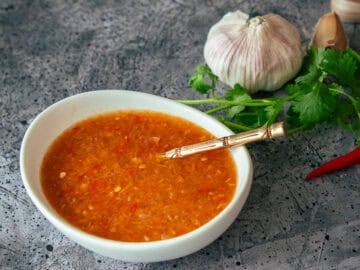
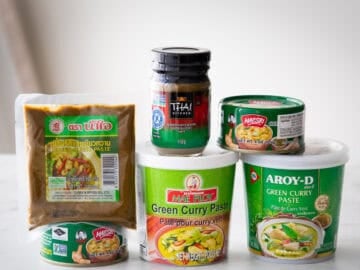
Brandon Hestwood says
Also, I want to add thanks to your posting weights and measurements. I cannot stand when people who post recipes that use 3 medium size tomatoes, a pinch of *****, one small onion, etc. It is all subjective! If someone is going to take the time and effort to post a recipe, they need to, at minimum, disclose accurate measurements. Thereafter, the one following the recipe can eyeball it to a degree of accuracy if they continue to make it.
Brandon Hestwood says
I’m making this tonight. I had a tough time sourcing the shrimp that didn’t come with a prop65 warning on it. So I decided to use salad shrimp, found in the frozen section at any supermarket. Thaw them overnight in the refrigerator, rinse them well, pat them dry, and throw them in a toaster oven at 145° for the first hour, and then reduce the heat to 125° for 6 to 8 hours. Hey, I ain’t about poisoning myself and fam just to eat good🤣.
Adrian Clegg says
I could not find Thai Curry Paste anywhere, but I did find something called Thai Red Paste, .......along with Thai Yellow Paste and Thai Green paste.
Can I use the Thai Red paste in place of the Thai Curry paste in the Cashew Chicken recipe??
Pailin Chongchitnant says
Unfortunately no, as those red/yellow/green pastes are curry pastes, whereas what you need it "chili paste". However, if you use red curry paste in a stir fry, it'll still be tasty, but it'll taste very different from what cashew chicken is supposed to taste like. Can give it a try anyway!
Barbara Hallett Wegner says
Can I use tamarind paste and maybe dilute it. Or do you think it's best to buy the tamarind and soak them for the juice. If I can use the paste what would you recommend
Pailin Chongchitnant says
My apologies for the confusion. The tamarind called for is Thai tamarind paste which you can buy in a tub ready-to-use, or make it from pulp (recipe linked in the ingredient list). I used to use the term "tamarind juice" but this caused confusion so I have since changed to calling it tamarind paste, but some older recipes still use the same terminology.
Barbara says
First time I made a dish with the jam was your shrimp and veggie recipe, I purchased the jam online as I can not find it around here and it was $9.00 for a 4oz jar. So made it with your recipe. THIS IS GOLD!!
What other dishes can I make with this other than the ones you mention.
My family loved the shrimp dish so much they keep asking for me to make it any. So I made the jam now have a ton as I doubled the recipe.
Justin says
Thai chili jam is by far my favorite thing to make in bulk. I like the dry roasting of herbals and have done something nearly identical to this but recently have been going the frying method:
70g dried long chilies (I can only get Indian where I am, once brought a bunch of fresh spur from Thailand and dried them on my balcony), stemmed and toasted most seeds removed, spice grinder when cooled
130g garlic sliced and fried til golden
170 g shallots sliced and friend til golden
5 stalks lemongrass sliced and fried til golden
50 g dried shrimp flash fried
Spice grind all fried stuff once cooled
40g shrimp paste
400 g palm sugar
.5 cup tamarind juice
.5 cup fish sauce
2 tsp toasted cumin
2 tsp toasted coriander
2 tsp white pepper
2 toasted star anise
Blitz the dry spices
Add everything to blender with 2 cups of water and go as long as you can
Add to 1cup oil in pot and simmer on low slightly covered for like an hour until super jammy with a little lair of oil on top!
The dried spices and lemongrass just give it a little something something
Justine Dadkhah says
Can this be bought ready made from the store?
Paul says
I made this for my Tom Yum soup. Your instructions and video make it so easy. Thank you very much.
William says
I have made this recipe several times, but notice that the Thai chili paste recipe in your recent book Sabai has increased the amount of fermented shrimp paste from 1/4 tsp to 1 tsp. Given the concentrated nature of this ingredient which do you recommend?
Pailin Chongchitnant says
Because the recipe in Sabai is a much bigger portion 🙂 The amount is the same proportionally.
Jo Mercer says
I used dried pasillo negro chiles (mild and already roasted)to great effect. I also substituted the Indian-style tamarind paste I had on hand, but only about a generous teaspoon plus 4 tablespoons of water.
I made thiis today to use in Pai's Tom Yum Pizza on Friday's Pizza Night!
Charles Pascual says
I've made this twice now - the first time to use in one of your recipes & this second time because I came across a recipe on another site that calls for it, with the usual link to purchase the prepared product on Amazon (to which I said, "nah, I can make this"). My go-to Thai-Viet market carries only fresh chiles, so I use a mix of mild & fruity, Mexican chiles - guajillo, ancho, pasilla, Morita - I don't know whether this makes my Nam Prik Pao non-authentic, but it tastes good to me. As you suggested, I tried this as "jam" on toasted English muffins (crumpets to you outside the US) and became addicted - I finished off the first batch this way in a few days. I expect this current batch will also end up this way too, after I use what I need in my recipe tonight. Thanks, Pailin.
Václav Š. says
How much do the chillies amount to in terms of volume once ground up? I don't have whole chillies, but I want to try the recipe using gochugaru.
Thank you for your answer. I cannot wait to try your tom yum goong recipe.
Václav Š. says
As I said, I could not wait to try. In the video it looks like a quarter cup, maybe more. I went ahead with a quarter cup or 20 grams of gochugaru and it turned out nice.
Pailin Chongchitnant says
You beat me to it, but 20g is exactly what you needed so good estimation!
Kal says
Could not find a local source of Spur chillies so I used Dried Anaheim aka California chillies and regular Red Onion came out great
Poonam says
I am allergic to shrimps.. what can replace this in the recipe?
Pailin Chongchitnant says
You can replace it with some bonito flakes, crush it up so it measures easily in a tablespoon, and omit the shrimp paste or use miso paste instead.
Dave S says
Pai
I made this tonight and just realized I left out the tamarind juice. Can this be added in after this is all done? What would you suggest?
Pailin Chongchitnant says
Answered you on Patreon! 🙂
Ifreet Taheea says
This is legit the OG jam recipe esp. for spice lovers. Goes soo well with toasted sourdough! Tried many recipes but keep coming back to this one.
Adam The HTK Intern says
Thanks! 🙂
Kim says
What premade brand of chili sauce do you recommend for those who don’t have time to make this? Thanks for all your recipes!!
Hendrik says
Yeah, that's what I'd like to know, too. I have the option of pantai or maepranom, and their ingredients read quite different.
Lisa says
Hi, really love all of your recipes.
But I just wondering, can I use fresh chillies in this recipe, instead of dry chillies? Cause fresh chillies are easier to find in my home. Thank you and happy cooking.
Adam The HTK Minion says
She says not for this one. Cheers!
Quin says
Made this to go with tomyam Goong. Oh it made all the difference. Yummmmmmssss
Megha says
Hi, I'm vegetarian. Would leaving the shrimps out work? Or would that change flavor profile? Are they any substitute for it?
Thanks
Pailin Chongchitnant says
It will still work if you leave it out, but it will lack umami, so try taking some dried shiitake mushrooms and finely grate for blitz it in a food processor into small pieces and add it in. I haven't done it myself but I think it should work!
NT says
Do you think mushroom broth powder would work as well, or dark miso? Thanks very much!
Pailin Chongchitnant says
I think both of those options are worth a try! Though because they are salty, you'd need to reduce the amount of salt (fish sauce in this case) in the recipe.
Luke Parlor says
Easy to make and very tasty paste/jam that adds a beautiful favour to just about anything you choose to add it to.